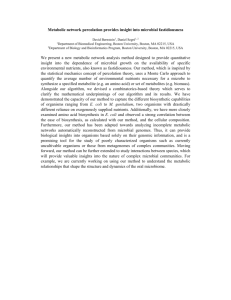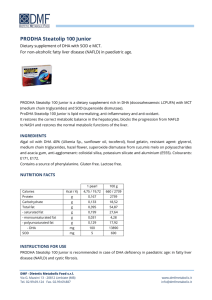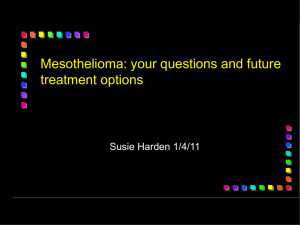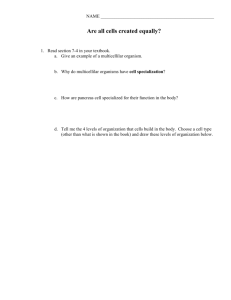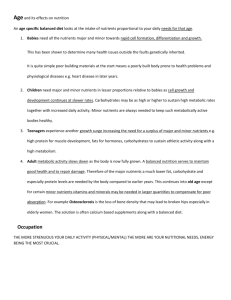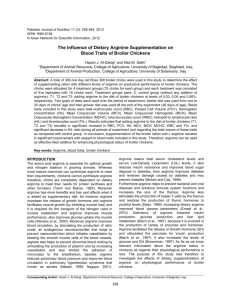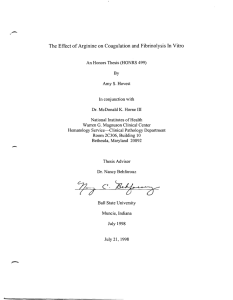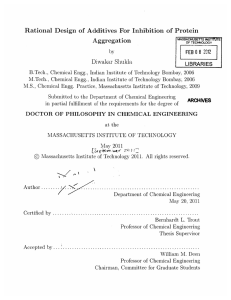Martindale - Immune modulating formulas FINAL
advertisement
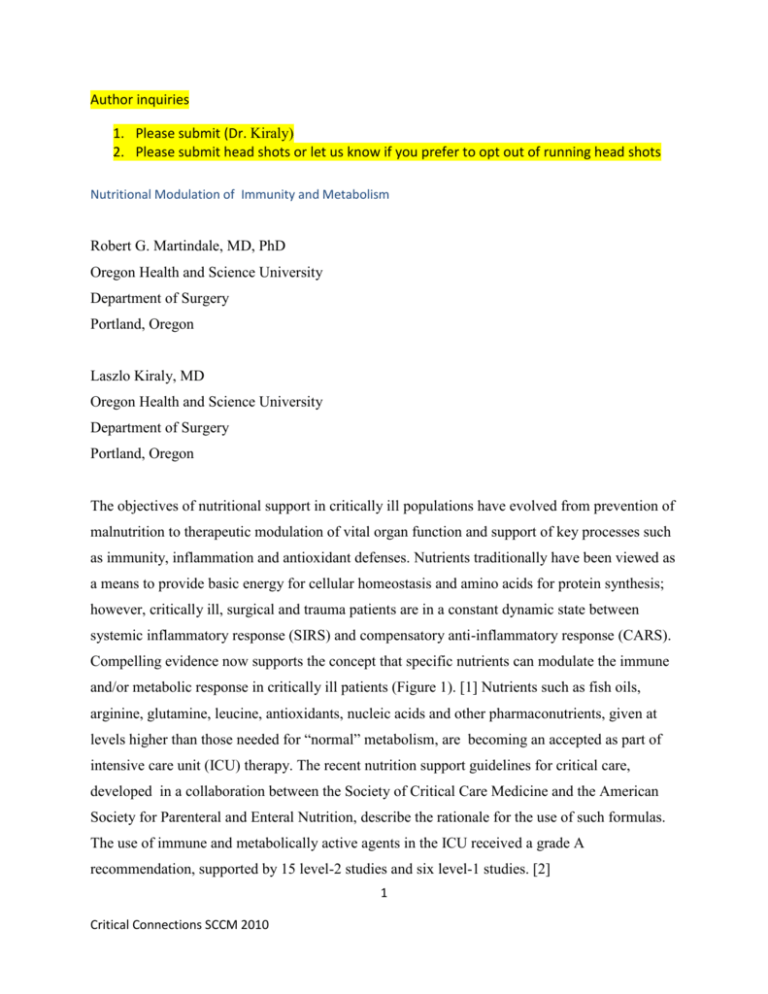
Author inquiries 1. Please submit (Dr. Kiraly) 2. Please submit head shots or let us know if you prefer to opt out of running head shots Nutritional Modulation of Immunity and Metabolism Robert G. Martindale, MD, PhD Oregon Health and Science University Department of Surgery Portland, Oregon Laszlo Kiraly, MD Oregon Health and Science University Department of Surgery Portland, Oregon The objectives of nutritional support in critically ill populations have evolved from prevention of malnutrition to therapeutic modulation of vital organ function and support of key processes such as immunity, inflammation and antioxidant defenses. Nutrients traditionally have been viewed as a means to provide basic energy for cellular homeostasis and amino acids for protein synthesis; however, critically ill, surgical and trauma patients are in a constant dynamic state between systemic inflammatory response (SIRS) and compensatory anti-inflammatory response (CARS). Compelling evidence now supports the concept that specific nutrients can modulate the immune and/or metabolic response in critically ill patients (Figure 1). [1] Nutrients such as fish oils, arginine, glutamine, leucine, antioxidants, nucleic acids and other pharmaconutrients, given at levels higher than those needed for “normal” metabolism, are becoming an accepted as part of intensive care unit (ICU) therapy. The recent nutrition support guidelines for critical care, developed in a collaboration between the Society of Critical Care Medicine and the American Society for Parenteral and Enteral Nutrition, describe the rationale for the use of such formulas. The use of immune and metabolically active agents in the ICU received a grade A recommendation, supported by 15 level-2 studies and six level-1 studies. [2] 1 Critical Connections SCCM 2010 The physiologist John Hunter, in 1784 in his book, “A Treatise on Blood, Inflammation and Gunshot Wounds: A Mechanism of Inflammation and a Comment That,” noted “many types of injury produce a similar inflammation.” Sir William Osler, in 1904, was quoted as saying “except on few occasions the patient appears to die from the body’s response to infection rather than from it.” These two insightful comments describe a major focus of critical care and trauma in 2010. Attempting to attenuate or control the metabolic response to stress and trauma at a manageable level, rather than allowing the extremes of the SIRS and the lows associated with CARS, is now a key to optimal ICU care. The physiologic response to stress is well described and includes a hyperdynamic cardiac and pulmonary response, insulin resistance, hyperglycemia, accelerated protein catabolism from the muscle, poor adaptation to use of alternate fuels, and increased oxidative stress. If the catabolic response goes on unabated, complex immunological changes result in immune suppression. [3] These observations in the critically ill population clearly indicate that delivery of just “calories and protein” to the persistently hyperdynamic stressed patient is not adequate. The concept of using specific nutrients for metabolic control was proposed in the late 1980s and now has become the standard of care for many critically ill, traumatized and surgical patients. The use of the omega-3 fatty acids (primarily eicosapentaenoic acid [EPA] and docosahexaenoic acid [DHA]) is at the center of this “pharmaconutrition” evolution. The ability to use specific nutrients to attenuate the metabolic response, reverse or minimize the loss of lean body tissue, prevent oxidative injury and favorably modulate the immune and inflammatory response is now available. These benefits have been noted by the appropriate use of omega-3 fatty acids, usually in the form of fish oil, arginine, glutamine and select other nutrients as part of enteral and parenteral nutrition programs. [2] Traditionally, lipids were felt to be important in clinical nutrition, but only as a source of calories and essential fatty acids and as support for the absorption of fat-soluble vitamins via micelle formation. Recent translational research has shown that fish oils can alter metabolic response to stress through multiple mechanisms; these include changes in membrane phospholipids yielding 2 Critical Connections SCCM 2010 a less inflammatory profile of leukotrienes, thromboxanes and prostaglandins; alterations in gene expression; and modulation of endothelial expression of intercellular adhesion molecule 1 (ICAM-1), E-selectin and other endothelial receptors regulating vascular integrity and function. [4] Additionally, EPA and DHA derivatives produced endogenously, including resolvins, docosatrienes and neuroprotectins, are potent active effectors of inflammation resolution. [5,6] Resolvins regulate polymorphonuclear neutrophil transmigration. Docosanoids and neuroprotectins are both derived from DHA and have potent neuroprotective properties. Neuroprotectin decreases neutrophil infiltration, proinflammatory gene signaling and NFκB binding. Neuroprotectin D1 has been found to reduce neural infarct volume by half in an animal ischemia-reperfusion model. [7,8] These protective mediators are highly conserved among species, from fish to mammals. [5] With the discovery of these compounds, inflammation resolution is acknowledged as an active process rather than a passive time-dependent one. In addition to the mechanisms mentioned, it has become apparent that fish oils also have a regulatory influence on the vagus nerve, as they have recently been shown to dampen the inflammatory response mediated via the vagal fibers. [9] The cardiac-stabilizing influence of fish oils has drawn interest in various acute clinical settings. Long-term consumption has protective effects against cardiac disease in large population studies. [10] Recently attention has focused on the acute effects of fish oils on the cardiac membrane. In 2005, Calo et al reported a randomized clinical trial in coronary artery bypass patients showing a 54% reduction in perioperative atrial fibrillation. [11] Several other reports have elucidated the potential mechanisms. [9,12] The greatest debate in the area of pharmaconutrition revolves around supplemental arginine use in the ICU setting. One school of thought holds that arginine is potentially toxic, whereas another argument is that arginine is deficient in critical illness and sepsis and should be supplemented. [13] A complete explanation and support for each argument are beyond the scope of this article and can be found in recent peer-reviewed articles. [14-16] No prospective clinical data support the concept that arginine is harmful, whereas numerous prospective articles have demonstrated supplemental arginine to be beneficial, especially in the surgical and trauma population. [17] 3 Critical Connections SCCM 2010 Glutamine is the other conditionally essential amino acid that has gained support in the critical care setting. Over the past 20 years, it has been reported to offer a myriad of benefits, including maintenance of acid-base balance, primary fuel for rapidly proliferating cells (i.e., enterocytes and lymphocytes), precursor in the synthesis of glutathione and arginine, reduction of insulin resistance and key substrate for gluconeogenesis. [18] Recent evidence that glutamine can induce heat-shock protein within several tissue beds is yet another beneficial molecular effect of this versatile amino acid. [18] The heat-shock proteins are a class of cellular chaperone proteins that support appropriate protein folding. By enhancing the these proteins, the cell protects itself from subsequent stress. [19] Numerous human studies have reported benefits from various combinations of metabolically active nutrients, including fish oils (DHA and EPA), arginine, glutamine, nucleic acids, and antioxidants. The disease states benefiting from these metabolic modulating formulations are wide ranging and spread over several systems. The nutrients have been shown to lower the incidence and severity of acute lung injury and adult respiratory distress syndrome, decrease adverse cardiac events and enhance early recovery from gastrointestinal surgery. Metabolic modulating formulas also have been shown to attenuate some of the adverse metabolic effects of sepsis. Not only have these human clinical studies shown benefit in shortening hospital stay and decreasing infections, but several have reported lower mortality rates. [20-22] Although the data overwhelmingly support the use of metabolically active agents, the optimal delivery route, timing of delivery, and dosage in trauma and critical care settings have yet to be determined by high-quality dose-response studies. The concept of pharmaconutrition is now clearly accepted by most clinicians. Ongoing studies will elaborate further which patient populations will maximally benefit. The use of fish oils, arginine, glutamine and other metabolically active nutrients is now becoming part of trauma and critical care nutrition protocols. Research focusing on the mitochondria and nucleus as nutrient sites of action will bring a whole new understanding of metabolic control in the critically ill 4 Critical Connections SCCM 2010 population. The principle of using nutrients as a therapeutic strategy rather than supportive one requires a shift in current dogma. Whether nutrients are used in combination or individually, these agents should be part of the intensivist’s armamentarium. Diagram 1: Metabolic Modulation with EPA and DHA 5 Critical Connections SCCM 2010


